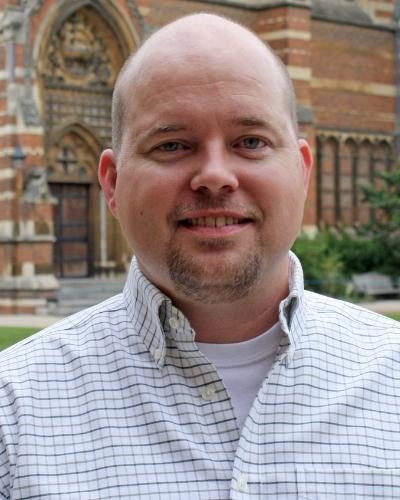
Jason DeBruyne, Ph.D.
Professor
Pharmacology & Toxicology
Neuroscience Institute
Location: Research Wing, Room 315
Phone: 404-756-5228
E-mail: jdebruyne@msm.edu
Education
POSTGRADUATE:
Perelman School of Medicine at the University of Pennsylvania, Philadephia PA
Senior Research Scientist
University of Massachusetts Medical School, Worcester MA
Postdoctoral Fellow
GRADUATE:
University of Houston, Houston TX
PhD in Molecular and Cellular Biology
Research Interests
- Molecular, biochemical, and genetic mechanisms underlying circadian rhythms in mammals,
- Roles of ubiquitin ligases in regulating circadian clock function
- Sex-specific circadian regulation of metabolism
- Neuronal regulation of sleep homeostasis in mammals
- Angelman Syndrome and its effect on sleep
- Genetics of sleep
Currently, my lab is using preclinical models to discover new mechanisms that drive
related but largely distinct processes: circadian rhythms and sleep homeostasis.
Circadian clocks influence nearly all aspects of mammalian life, aligning our internal
physiological process to optimal times of day. Understanding the molecular circuitry
keeping circadian time provides insight into how the clock drives overt rhythms and
what to fix when the circadian system is disrupted (i.e. during shift work). One of
our major goals in this area is to uncover new regulators circadian clock function
that may lead us to better understanding and potential therapeutic targets. This work
so far has led us to discover the unexpected existence of highly sex-specific circadian
mechanisms that appear to drive some of the substantial sex-differences in metabolism.
Thus, we also now also focused on understanding the nature of sex-specific circadian
mechanisms, as they may help explain why males and females suffer different consequences
to shift work and other circadian-based disruptions.
Sleep problems are probably the most widely recognized consequences of circadian disruption, but sleep is also highly regulated by a completely unknown homeostatic mechanism. This homeostatic mechanism increases the drive to sleep in response to extended wakefulness and sleep deprivation, but how it operates is a tremendous gap our understanding. We recently discovered that the genetic cause of the neuro-developmental disorder Angelman syndrome (loss of function of the Ube3a gene in neurons within the brain) also disrupts homeostatic sleep responses, providing us a novel genetic tool probe this mechanism. Currently, our goals are to use the neuronal loss of Ube3a loss determine if it has potential as therapeutic target for sleep disorders and to identify the specific brain regions and neurons responsible sleep homeostasis – identifying these neurons will rapidly precipitate understanding of its mechanisms, ultimately leading to better treatments of insomnias and other sleep disorders.
Publications
- Mekbib T, Suen T-C, Rollins-Hairston A, Smith K, Armstrong A, Gray C, Owino S, Baba K, Baggs JE, Ehlen JC, Tosini G, DeBruyne JP. A novel female-specific circadian clock mechanism regulating metabolism”. bioRxiv 2021.10.05.326652; doi: https://doi.org/10.1101/2020.10.05.326652
- Buonfiglio D, Hummer DL, Armstrong, A., Ehlen, JC, DeBruyne JP. Angelman syndrome and melatonin: what can they teach us about sleep regulation. Journal of Pineal Research. 69(4):e12697. doi: 10.1111/jpi.12697. Epub 2020 Oct 11. PMID: 32976638. 2020
- Mekbib T, Suen T-C, Rollins-Hairston A, DeBruyne JP. The E3 ligases Spsb1 and Spsb4 regulate RevErbα degradation and circadian period. Journal of Biological Rhythms. 34(6):610-62. 2019
- Ehlen, J.C., Jones, K.A., Pinckney, L., Gray, C.L., Burette, S., Weinberg, R.J., Evans, J.A., Brager, A., Zylka, M.J., Paul, K.N., Philpot, B.D., and DeBruyne, J.P. “Maternal Ube3a loss disrupts sleep homeostasis but leaves circadian rhythmicity largely intact”. Journal of Neuroscience 35(40):13587-98, 2015.
- DeBruyne, J.P., Baggs, J.E., Sato, T.K., and Hogenesch, J.B., “The ubiquitin ligase Siah2 regulates RevErba degradation and the mammalian circadian clock”. PNAS , 112(40):12420-25, 2015.
CLICK HERE to view additional publications.
